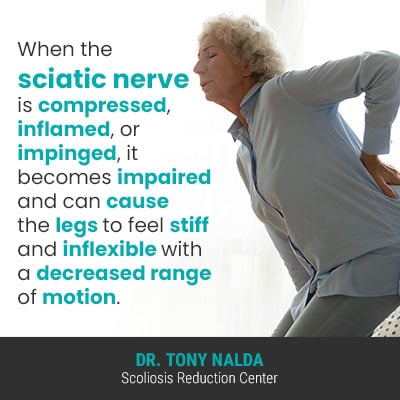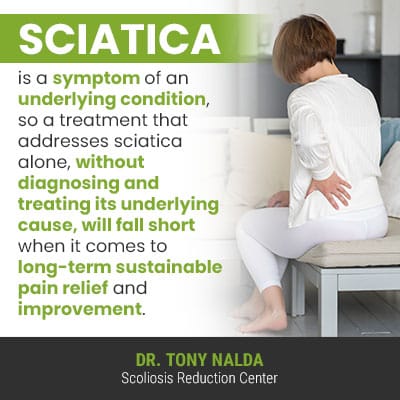Conditions with nerve involvement can be unpredictable as they can range from mild to severe, involve intermittent flare-ups, or be chronic and debilitating. The sciatic nerve is the largest in the human body, originating in the lower back and traveling down the buttock, leg, and into the foot. Most often, sciatic nerve pain is felt on the left side of the body and has a variety of causes.
Sciatica involves discomfort felt along the sciatic nerve pathway, which is extensive. If the sciatic nerve is exposed to compression and/or impingement, it can become irritated, damaged, and cause pain that might not go away easily; effective treatment has to address its underlying cause.
To answer the question, why is my sciatica not going away? Let’s first explore the connection between the spine and the sciatic nerve for a better understanding of the condition as a whole.
The Spine and Its Nerves
The spine is a key structure of human anatomy not only because it supports the weight of the head and trunk, enables flexible movement, and absorbs mechanical stress, but also because it works in tandem with the brain to form the central nervous system (CNS).
The central nervous system facilitates brain-body communication, so the spine and its nerves are involved in the function of virtually every working system within the body.
The spine consists of vertebrae (bones) stacked on top of one another in a neutral and straight alignment and separated by intervertebral discs.
The vertebrae have hollow openings in their centers, forming a type of tunnel through which the spinal nerves pass and project into different areas of the body.
The Sciatic Nerve
The sciatic nerve is the largest and longest nerve, starting in the lumbar spine (lower back) with the joining of motor and sensory fibers from the L4 to S3 spinal nerves.
The sciatic nerve branches out from the lumbar spine into different areas of the body, and as nerves branch off in multiple directions, pain from nerve compression can be felt far from the nerve’s site of origin.
The sciatic nerve supplies the majority of the lower body: thigh, leg, and foot. It’s responsible for the motor and sensory functions of the lower part of the body, such as walking, running, standing, etc.

When the sciatic nerve is compressed, inflamed, and/or impinged, it becomes impaired and can cause the legs to feel stiff and inflexible with a decreased range of motion.
In addition, sciatica can involve severe pain, weakness, and/or tingling felt in the lower back, buttock, leg, and foot.
Problems with the sciatic nerve can start at the root level in the lumbar spine, where it originates, or anywhere along the nerve’s pathway; in most cases, symptoms are experienced in the areas closest to the affected nerve.
When a sciatic nerve root is affected in this way, it’s called lumbar radiculopathy, but is commonly referred to as sciatica.
There are a number of causes for sciatica, and effective treatment involves diagnosing and addressing its underlying cause.
Sciatica Causes
Sciatica is a symptom of an underlying condition, so treatment that addresses the sciatica alone, without diagnosing and treating its underlying cause, will fall short when it comes to long-term sustainable pain relief and improvement.
Here at the Scoliosis Reduction Center®, I believe there is a big difference between addressing pain as a symptom, or its underlying cause: the condition itself.
When it comes to sciatica, there are many different causes, some of the most common including intervertebral disc issues, age-related spinal degeneration, and spinal conditions such as stenosis and scoliosis.
If you are experiencing sciatic nerve pain that’s not abating with treatment, make sure your treatment plan addresses the sciatic nerve pain as a symptom but is driven by its underlying cause.
Why is my Sciatica Pain Not Going Away?
Effective treatment for sciatic nerve pain has to acknowledge its underlying cause, so once the cause of sciatic nerve compression and/or impingement is determined, it can shape the design of treatment plans moving forward.
For example, if only pain medications are being taken as a form of treatment, they can help with short-term pain management, but do nothing to actually address the cause of the discomfort for long-term improvement.
If an intervertebral disc, for example, in the lumbar spine becomes desiccated, bulging, or herniated, they can change shape and affect the overall structure/function of the spine; as the discs give the spine structure by adjacent vertebrae attaching to them, if they deteriorate and move, it can alter the position of adjacent vertebrae, introducing uneven forces and adverse spinal tension.
When the spine and its surroundings are exposed to uneven forces, this includes the spinal nerves, and if a bulging and/or herniated disc is encroaching on the space within the spinal canal, through with the sciatic nerve passes, it can cause compression of the nerve root, and sciatic nerve pain as a result.
Many cases of sciatica resolve on their own in a matter of weeks or months, but particularly when sciatic nerve pain is caused by natural age-related spinal deterioration and the cumulative effect of certain lifestyle choices, if contributing factors aren’t addressed to preserve the health of the spine and prevent further damage, sciatica can last longer and/or become a chronic issue.
Sciatica Treatment

While a certain amount of spinal degeneration is expected with age, additional lifestyle factors can play a role over time. If the sciatica is not going away, lifestyle improvements might be necessary.
For example, maintaining a healthy weight is important as carrying excess weight puts added strain, and related wear and tear, on the joints of the spine.
Also read: How To Cure Sciatica Permanently
As the lumbar spine not only has to support the weight of the spinal sections above and bears the brunt of the body’s trunk weight, it also feels the full effect of bending, twisting, and lifting motions.
If a healthy weight and activity level are maintained, this means a spine that is stronger, less strained, and more flexible; it also means stronger core muscles so the spine is optimally supported and stabilized.
A spine with optimal support from its surrounding muscles is taking pressure off the spine, and its parts, such as its discs, that are generally the first spinal structures to show the effects of degeneration.
Here at the Center, when lifestyle factors play a role, lifestyle guidance becomes one part of an integrative treatment approach that combines multiple treatment modalities for the best potential results.
If an underlying spinal condition such as lumbar stenosis or scoliosis is causing the sciatic nerve compression, treatment involves increasing space within the spinal canal so the sciatic nerve has optimal space in which to function. Also, addressing the unnatural scoliotic curve on a structural level improves spinal mechanics and reduces uneven forces.
In order for the spine to function optimally, it needs to maintain its natural curvatures and alignment, so any type of degeneration, condition, or injury that compromises the spine’s ability to do so has the potential to cause compression and related symptoms such as sciatica.
Conclusion
When it comes to proactive treatment for sciatica, this involves comprehensively assessing the sciatic nerve pain as a symptom and determining its underlying cause.
There are different causes of sciatica that range from natural age-related spinal degeneration coupled with the cumulative effect of certain lifestyle choices, intervertebral disc issues that affect the structure and function of the spine, to the presence of larger underlying spinal conditions such as stenosis and scoliosis.
If sciatica is not going away on its own, it’s likely that the sciatic nerve pain isn’t due to an overuse injury or recent strain that will abate with rest, and in many cases, the longer it lasts, the more likely it is that it’s due to an underlying issue needing proactive treatment.
Here at the Scoliosis Reduction Center®, my sciatica patients benefit from a proactive and chiropractic-centered treatment approach that first determines the underlying cause of the sciatic nerve pain, and crafts effective treatment plans around it.
While there are never treatment guarantees, by combining condition-specific chiropractic care, in-office therapies, and custom-prescribed home exercises, sciatic nerve pain can be addressed through lifestyle improvement, restoring disc position, health, and function, preventing further damage, and proactively treating spinal conditions that involve a loss of nerve space and healthy spinal curves.





